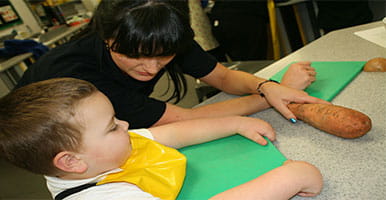Introducing complementary foods

What age should foods be introduced?
From around 6 months of age babies should be introduced to complementary foods alongside breastfeeding or formula feeding. At this age, complementary foods do not replace breast or formula milk, which continue to provide the majority of a baby’s nutritional requirements. Introduction of complementary foods should be based on developmental readiness: baby is able to sit up, hold head up and able to pick up food and put it into their mouth, able to swallow the food.
Baby-led or spoon feeding?
Introducing foods can be in the form of spoon feeding, baby-led feeding (where a baby is only given finger foods and feeds themselves from the start) or a combination of the two. There is no evidence at present to show one method is more effective than the other.
Responsive feeding
As with breast and bottle feeding, responsive feeding (i.e., listening to baby’s hunger and fullness cues) can help babies learn to self-regulate their food intake and can reduce over feeding.
Tips for introducing complementary foods responsively
|
Age-based guidance for introducing foods
Click on the drop-down boxes for guidance on introducing foods at each age.
Faq Items
6 months
7-9 months
10-12 months
12 months +
Dairy products and non-dairy alternatives
Dairy products should be full fat and pasteurised to meet babies’ nutritional requirements (these have better vitamin A content than low fat products). They should also be unsweetened e.g., Plain yoghurt.
Breastmilk or cow’s milk can be used in cooking but cow’s milk should not be used as a drink until 12 months.
Non-dairy alternatives (e.g., Soya, Oat, Coconut) should not be given to children under 2 years, and should only be given to children under 5 years with special reasons such as milk allergy or intolerance. This is because most non-dairy milks are very low in protein and essential micronutrients.
Commercially produced baby foods in pouches
Where possible, it is better to use fresh, frozen and canned fruit and vegetables. If using commercially produced baby foods in pouches, there are concerns that due to removal or disruption of fibre from these foods this can lead to reduced infant and child satiety and can lead to overfeeding. They are also more likely to contain free sugars, which can lead babies to gain excess weight. In addition, as many of the pouches contain combinations of foods, infants are unable to recognise individual foods. Babies and infants should never feed directly from the pouch as this can lead to choking.
Foods to avoid
Certain foods should be avoided for infants under the age of 12 months, including sugar, salt and foods high in saturated fats. More specific foods should not be given e.g., honey, whole nuts. The NHS provides a list of foods to avoid giving babies and young children.
Snacks
Snacks are not required until after 12 months. If babies are hungry milk can be offered instead.
Drinks
By 6 months babies should be offered sips of tap water from a free-flowing valve free cup or open cup to prevent tooth decay. Juice, fizzy drinks, squash milk shakes should be avoided, they can lead to tooth decay and contain free sugars which can lead to weight gain and later obesity.
Babies under 12 months should not have cow’s milk as a drink (although it can be used in cooking). As noted above, children under 2 years should not drink non-dairy milk alternatives, and these should be avoided if possible under 5 years (unless there is a milk allergy or intolerance, in which case fortified versions can be given to 2-4 year olds).



